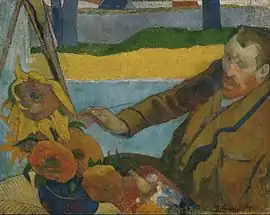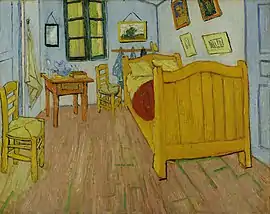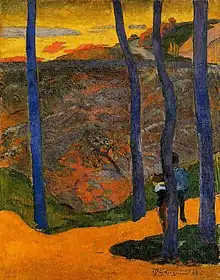The Painter of Sunflowers (in French: Le Peintre de Tournesols) is a portrait of Vincent van Gogh by Paul Gauguin. Van Gogh is depicted sitting before an easel, presumably painting his “Sunflower” series. The work, which is a piece from Gauguin’s “Arles Period”, was created in Arles, France, in December, 1888.[1] The painting is in the collection of the Van Gogh Museum in Amsterdam.[2]
| The Painter of Sunflowers (Portrait of Vincent van Gogh) | |
|---|---|
 | |
| Artist | Paul Gauguin |
| Year | 1888 |
| Medium | Oil on canvas |
| Dimensions | 73 cm × 91 cm (28.7 in × 35.8 in) |
| Location | Van Gogh Museum |
Background
The portrait was painted when Gauguin lived with Van Gogh in Arles. Van Gogh had asked Gauguin to stay with him and form an art colony that he referred to as "The Studio of the South".[1] After much urging and extensive correspondences, Gauguin agreed to move to Arles in October, 1888.[3] Gauguin was financially supported by Van Gogh’s brother, Theo Van Gogh, who paid Gauguin a stipend of 150 francs in return for completing one painting a month.[1]
Gauguin stayed in Arles from October to December, during which time the two artists found themselves regularly at odds.[3] The artists had differing opinions in regards to artistic expression and freedom of representation, and their contrasting beliefs led to tension between them.[4]
The completed Painter of Sunflowers was shipped to Theo Van Gogh on December 20, 1888, shortly after an incident between the artists during which Van Gogh allegedly threw a glass of absinthe in Gauguin’s face. Days later, on December 23, 1888, a disagreement with Gauguin was followed by the famous incident of Van Gogh severing his own left ear with a razor.[1] Afterwards, Gauguin wrote to Theo saying, "Everything considered, I am obliged to return to Paris. Vincent and I simply cannot live together without trouble, due to the incompatibility of our characters, and we both need tranquility to work".[5]
Gauguin admitted that his portrait of Van Gogh was not a perfect likeness, but he felt that he had captured his friend's intimate character. Van Gogh's initial impression of the painting was that Gauguin had depicted him as a madman; he stated, "It is certainly I, but I gone mad".[5] He later softened his view, saying, "My face has lit up after all a lot since, but it was indeed me, extremely tired and charged with electricity as I was then."[2]
Composition


The painting shows Van Gogh working in what he called “The Yellow House,” and it includes recognizable features of other notable works.[6] For example, the blue walls in the painting are also visible in Van Gogh’s Bedroom in Arles, and the chair Van Gogh is seated in is likely the same as the one depicted in the painting Van Gogh’s Chair.[7] Hanging on the wall behind Van Gogh we can see an enlarged portion of one of Gauguin's paintings. It was not uncommon for Gauguin to display his own paintings in the background of his works, and the one depicted here is most similar to his painting Blue Trees.[6]
Though Gauguin would have viewed Van Gogh painting many times, it is likely that this portrait scene was done mostly from memory. A key indicator of this is that the work was completed in the winter of 1888, but depicts a scene from the summer, suggesting that Gauguin developed the concept of the painting first, and then later added details observed from life.[1]
In the painting, Gauguin depicts Van Gogh as seen from above, sunken into his chair with his eyes slightly closed. Art historians have noted that Van Gogh's head appears distorted, with a sloping shape and flat features.[8] From this composition, some have suggested that Gauguin was representing Van Gogh's deteriorating mental state, rather than his true likeness.[6]
Style and influences
Gauguin’s early work was still indebted to the Impressionist style, an artistic movement that centered around painting from observation and capturing transient moments. From his time in Arles, however, Gauguin’s work is considered to be Post-Impressionist, due to its developed individual style and departure from observed appearances.[9]
Though Gauguin and Van Gogh worked closely together, they had different influences on the style of their painting. While at Arles, Gauguin stated in a letter that Van Gogh "admires Daudet, Daubigny, Ziem and the great Rousseau, all people I cannot understand, and on the other hand he detests Ingres, Raphael, Degas, all people whom I admire."[10]
Chemical analysis
X-radiographs of the canvas and microscopic analysis of the paint reveal that the work was likely done on a coarse, jute fabric, and used a palette of optically pure lead pigments including white, vermillion, chrome yellow, synthetic ultramarine, and more. The X-radiograph also revealed the areas of the painting that are most dense with paint, such as the foreground figure, the wall and the sunflowers. These areas of heavily applied paint suggest that Gauguin likely blocked out the composition first, then built up the paint as he worked.[1]: 127–128
Ownership
The painting remained in Theo Van Gogh’s possession from 1888 until his death in 1891, after which it was passed down through his family until eventually being given to the Van Gogh Foundation in 1962. The painting has been since placed in the Vincent Van Gogh Museum in Amsterdam from its opening in 1973.[2]
See also
References
- 1 2 3 4 5 6 Wasiutynski, Jirat (2000). Technique and Meaning in the Paintings of Paul Gauguin. Cambridge, United Kingdom: Cambridge University Press. pp. 115–136. ISBN 0521642906.
- 1 2 3 "Vincent van Gogh Painting Sunflowers Paul Gauguin, 1888". Van Gogh Museum. Retrieved 2023-11-19.
- 1 2 Rapetti, Rodolphe (2003). "Gauguin, Paul". Grove Art Online. doi:10.1093/gao/9781884446054.article.T031013. Retrieved 2023-11-19.
- ↑ Colins, Bradley (2001). Van Gogh and Gauguin: Electric Arguments and Utopian Dreams. Boulder, CO: Westview Press. pp. 65–85. ISBN 0813335957.
- 1 2 Rewald, John (1956). Post-Impressionism: From Van Gogh to Gauguin. New York: Museum of Modern Art. pp. 241–268. ISBN 0810960664.
- 1 2 3 Gayford, Martin (2006). The Yellow House: Van Gogh, Gauguin, and Nine Turbulent Weeks in Arles. New York: Little, Brown and Company. pp. 238–245. ISBN 0316769010.
- ↑ Groom, Gloria (2016). Van Gogh's Bedrooms (1st ed.). The Art Institute of Chicago. pp. 127–130. ISBN 9780300214864.
- ↑ Druick, Douglass (2001). Van Gogh and Gauguin: The Studio of the South. The Art Institute of Chicago. pp. 236–240. ISBN 0500510547.
- ↑ "Paul Gauguin | Biography, Tahiti, Vincent van Gogh, Artworks, & Facts | Britannica". www.britannica.com. 2023-10-20. Retrieved 2023-11-20.
- ↑ van Uitert, Evert (1977). "Vincent van Gogh and Paul Gauguin: A Creative Competition". Simiolus: Netherlands Quarterly for the History of Art. 9 (3): 149–168. doi:10.2307/3780334. ISSN 0037-5411. JSTOR 3780334.